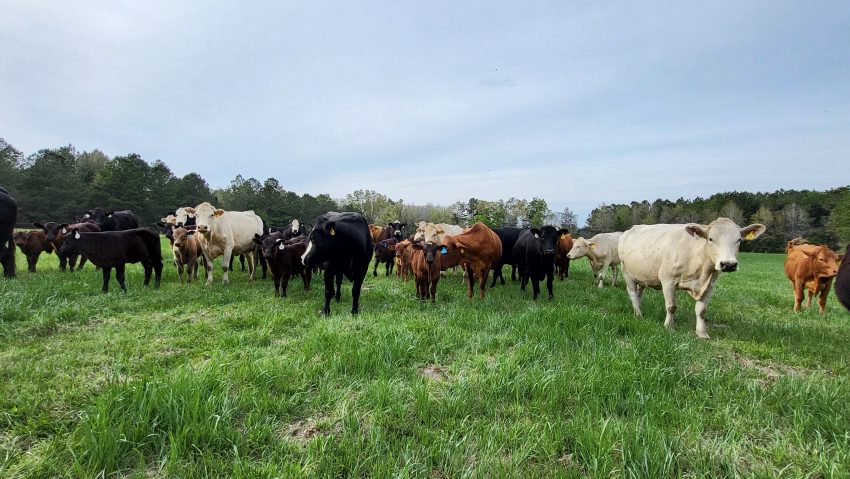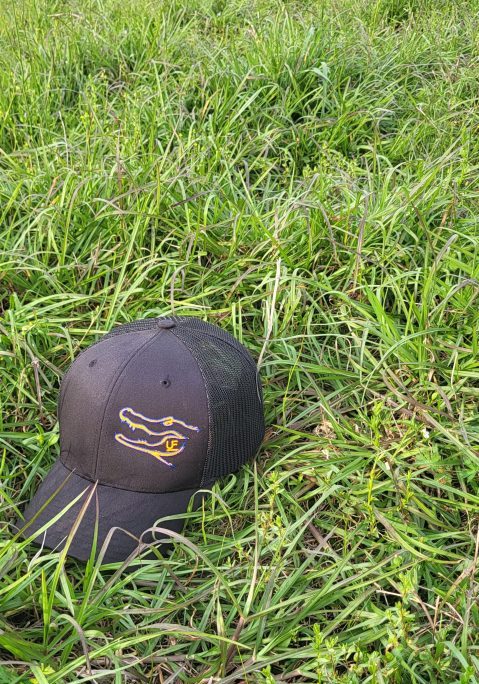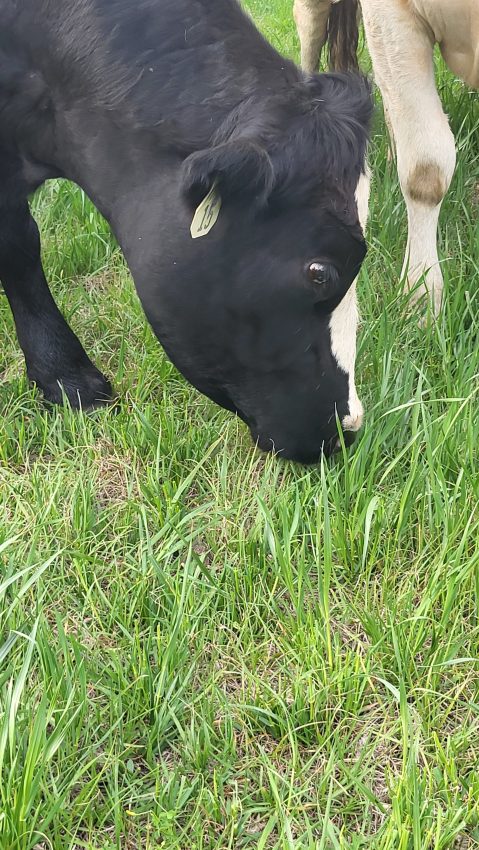
Cattle grazing Earlyploid ryegrass in Washington County, which was overseeded into a Tifton-9 bahiagrass pasture. This photo was taken the last week in March – during the spring transition when grazing management is particularly important. Photo Credit: Mark Mauldin, UF/IFAS
The calendar and the weather agree, spring has sprung. Earlier today I made two observations which lend further credence to that conclusion. 1) my truck has turned yellow (under a thick coating of pollen) and 2) there was a line, literally out the door, at a local feed and seed with most of the patrons holding baby chicks, garden plants, or both. It’s definitely spring, and that generally makes cattle producers smile since it means the end of the winter-feeding season is close at hand. While that is true, there is still work to be done to optimally manage your forage resources through the spring transition.
The hay barn is almost empty, and the pastures are green – I completely understand the allure of just opening the gate and moving on to something other than feeding cows. However, for the long-term health and season-long total production of the pasture, you might want to take a moment before you do. Warm-season perennial pastures (bahia, bermuda, limpograss, etc.) survive their winter dormancy by metabolizing stored energy. This is the same supply of stored energy that they utilize to regrow after they have been grazed or mowed. When spring arrives and the grasses begin to break dormancy their supply of stored energy is low, since it has been slowly consumed all winter long. Then they expend considerable energy growing new leaf tissue. At this point the plants have very little energy reserves left. In general terms, this is the current condition of most pastures in Northwest Florida right now.
Through the miracle of photosynthesis, green leaves in the sun equate to energy production for plants. The more leaf area in the sun the more energy is produced. Much of the energy being generated is used for leaf and root growth but some is used to replenish the supply of stored energy, which will later be used to fuel the plant’s regrowth after grazing. With cool nighttime temperatures, relatively short days, and limited leaf area currently available for photosynthesis, early regrowth and replenishment of stored energy is a slow process.

Limpograss in Washington County showing a considerable amount of growth on March 25th. Limpograss is less daylength sensitive than bahia or bermudagrass allowing it to start growing as soon as temperatures warm sufficiently. Even though it looks good, this grass is several weeks away from being tall enough to graze. Photo Credit: Mark Mauldin, UF/IFAS
Insert hungry cows too early, who graze off the leaves where photosynthesis is happening, and the process grinds nearly to a stop. At this point, with very little stored energy left, the plants must dip even deeper into their reserves to produce more leaf tissue. This puts the plants in a very precarious place. They become highly susceptible to disease, insect, and especially drought stress. Conditions that would otherwise not be an issue can now become very serious problems. Even if outside stressors and their potentially catastrophic impacts are avoided, there is still a price for grazing too early. Remember, leaves in the sun equal energy production, and energy is what the plants really need at this point in the scenario. In a situation like this, as a survival mechanism, the plants will shift resource allocation away from root growth in favor of leaf tissue production. The plants will have naturally sloughed off lots of roots over the winter. This tissue needs to be replaced for the plant to effectively capture water and nutrients. The plant’s inability to maintain its root system will negatively impact performance and make the plant much more susceptible to drought. The longer the plants lack adequate leaf area the weaker they become until they eventually die. At field scale this presents as a thinning stand which leads to an increase in weed pressure and a considerable decline in overall productivity.
The scenario described above illustrates how grazing too hard too soon can be very damaging to pastures. The effects of over grazing are magnified during the spring transition when are grasses are more fragile than they are later in the year. It is easy to overgraze during the spring transition, because the plants are not in a position to handle much grazing pressure. The exact same grazing practices that are perfectly fine and sustainable in the summer (ie. a given number of cows on a given number of acres for a certain number of days) can be very problematic in the early spring.
All this boils down to a very simple concept – let the grass get further ahead of the cows than you normally would before the first grazing in the spring and then be sure to graze off no more than half of the standing biomass the first time you graze the pasture. Just an extra week or two of growth prior to grazing can go a long way towards maintaining a strong healthy pasture which will ultimately result in more season-long forage production.

If you look closely, you can see both annual ryegrass and perennial bahiagrass in the sward. Unfortunately, cows like the one pictured here don’t know to graze the ryegrass and leave the bahiagrass, making grazing management in these systems somewhat complex. Photo Credit: Mark Mauldin, UF/IFAS
When perennial pastures are overseeded with cool season annuals management through the spring transition becomes even more complicated. Everything previously described remains true for the perennial grass but now there is a cool-season annual forage in the same space that must be managed also. By this time of year, many small grains (rye, oats, triticale) are trying set seed, meaning their vegetative growth is over. While annual ryegrass is entering its period of peak productivity, making its management in these systems a bit more involved.
It is crucial that the annuals be grazed sufficiently to prevent them from shading the perennial as it breaks dormancy. Shade has the same negative effect as grazing too early, but it can be even more damaging since there is virtually zero opportunity for photosynthesis under a dense canopy of annual forage (this is particularly true of ryegrass since its growth habit is not as upright as the small grains). Shading can be prevented through frequent, light grazing which tops the annuals allowing light down the perennial. Be careful not to graze the annuals down below the height of the perennial grass as it is still crucial that the perennial grasses not be grazed too early. To make all this work, takes quite a bit of active management and a willingness to move cattle, sometimes quite frequently.
As with all agricultural endeavors, the weather always has the potential to further complicate forage management, especially during the spring transition. Dry conditions in the spring can be particularly hard on perennial forages, and the situation can be wildly exacerbated if grazing management is not adapted correctly. If drought conditions develop in the spring and the grass stops growing, do not let the cows graze it down to the ground (like we do in the fall) – pull them off when there are still several inches of leaf and go back to feeding hay. I know that no one wants to do that, but the benefit to the pasture will pay for the extra hay in the long run.
While most of our perennial forages are quite hardy and can withstand considerable abuse they are, without doubt, the most vulnerable to the impacts of mismanagement, particularly overgrazing, in the spring. It is crucial that forage mangers consider the physiological challenges that their pastures face during the spring transition and take the necessary steps to protect the long-term productivity of their pasture resources.
- Peanut Maturity Update – 10/9/25 - October 10, 2025
- Fall Can be a Great Time for Vegetation Management - October 3, 2025
- Peanut Maturity Update – 9/25/25 Edition - September 26, 2025
